The Anglo-Saxon Conquest (5th – 8th cent. AD)

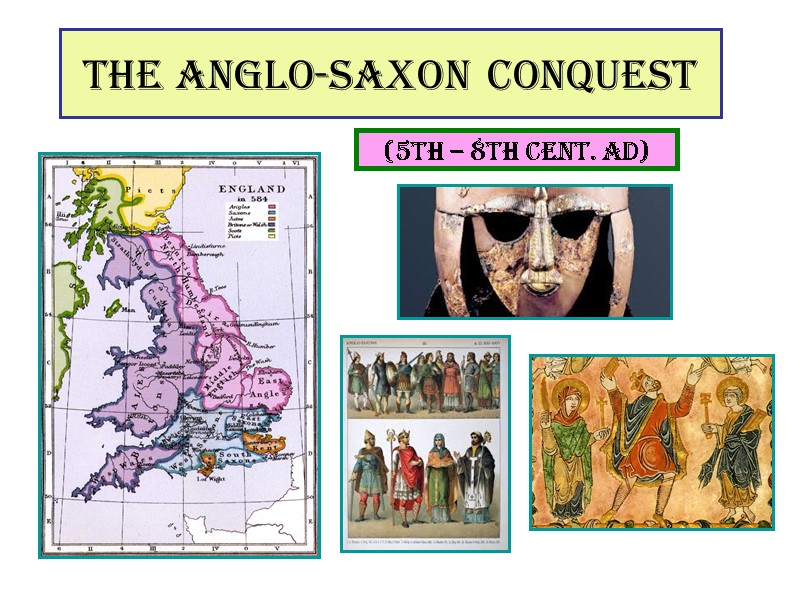

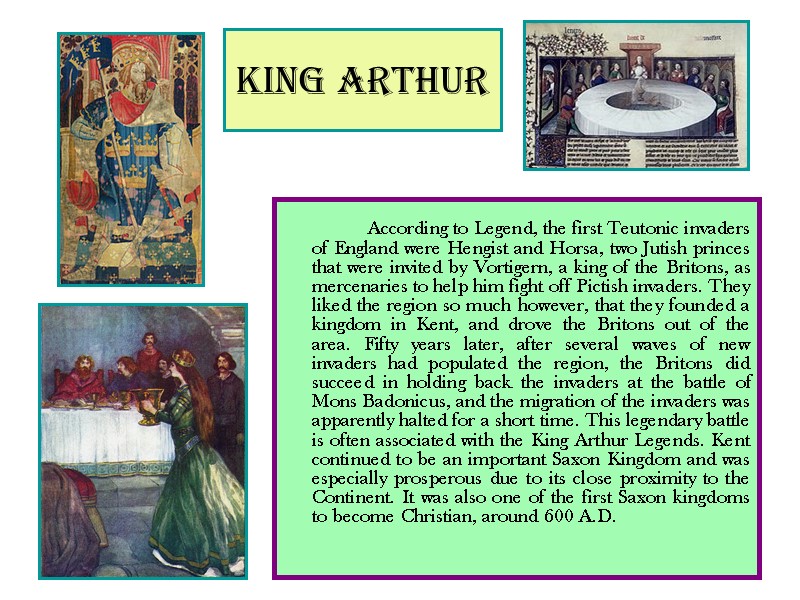
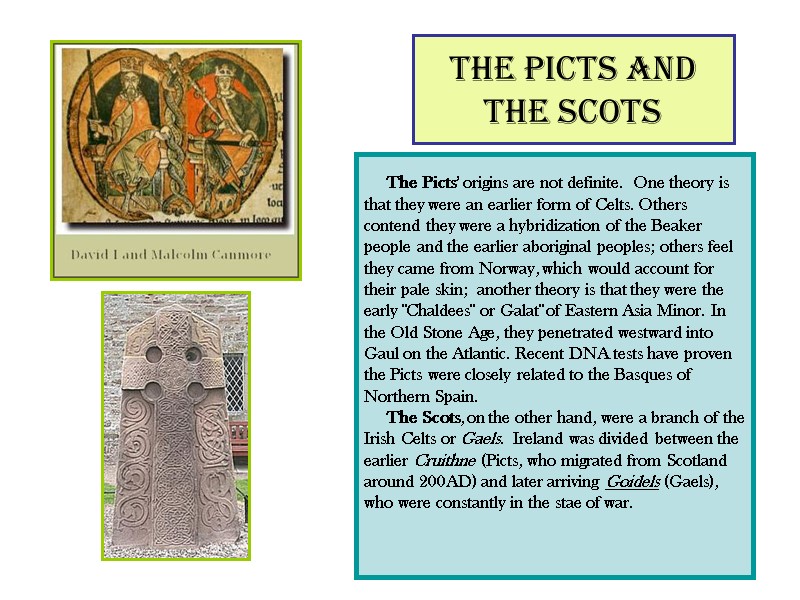
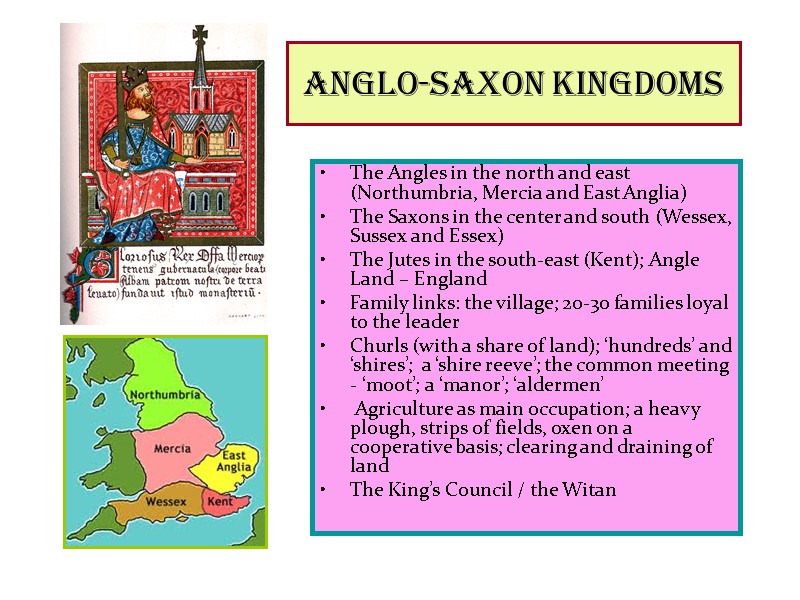
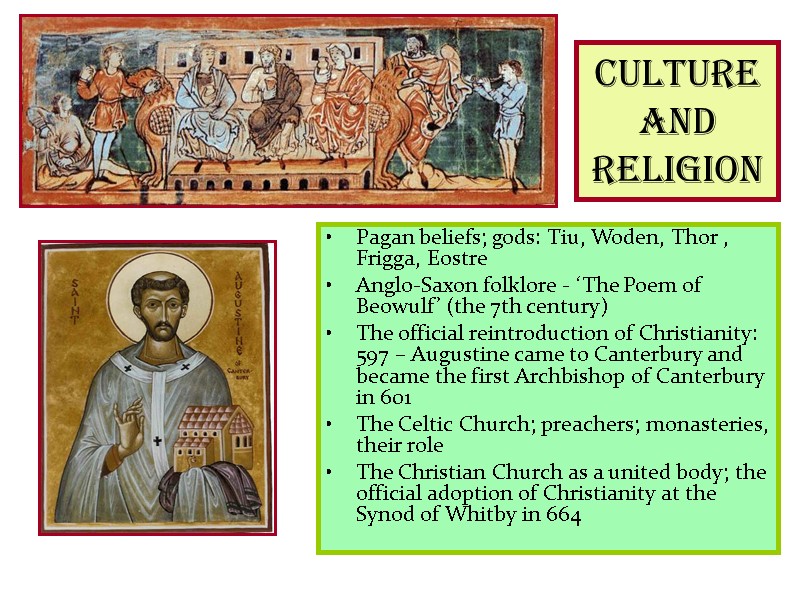
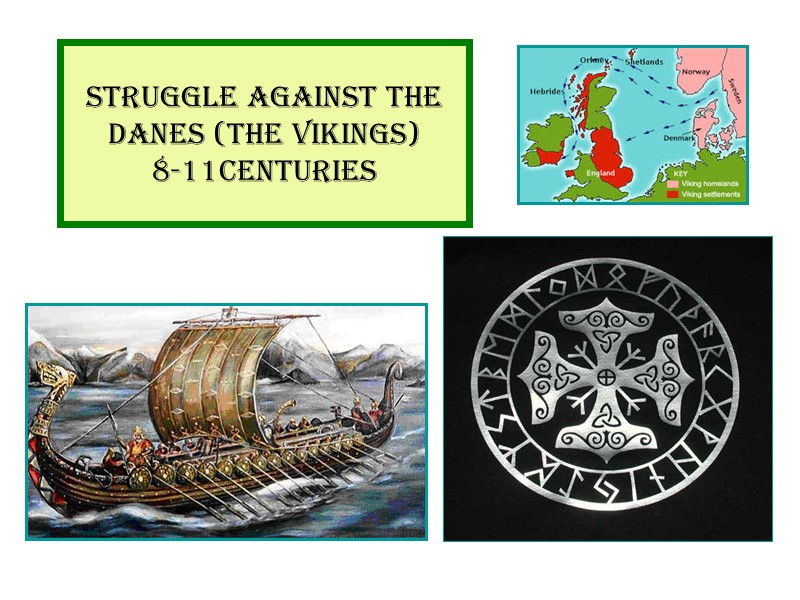
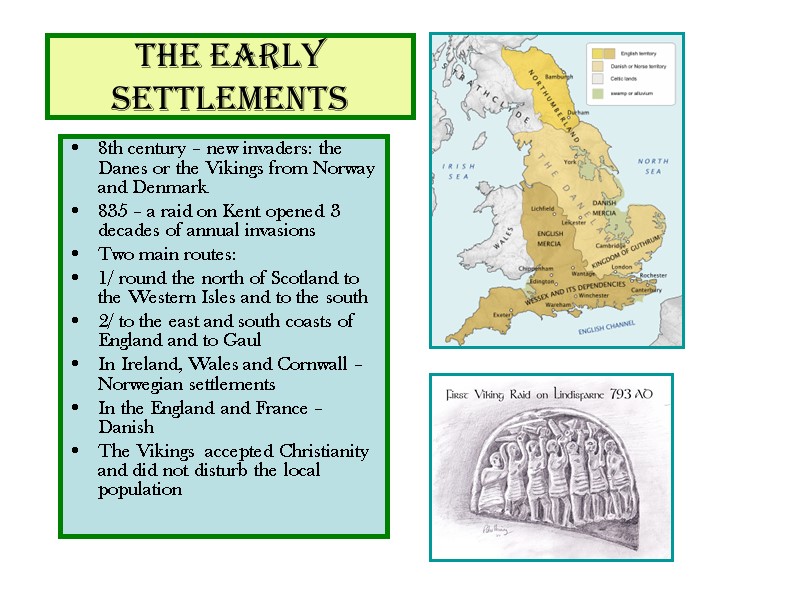
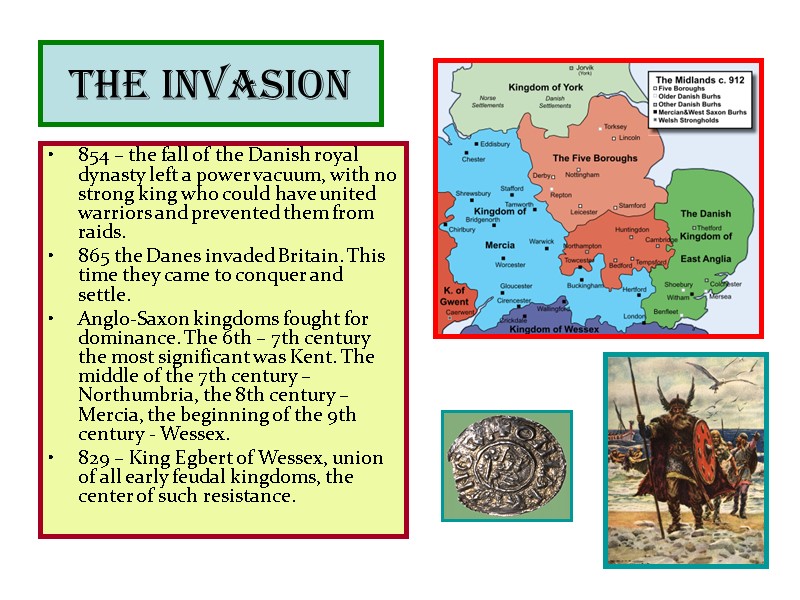
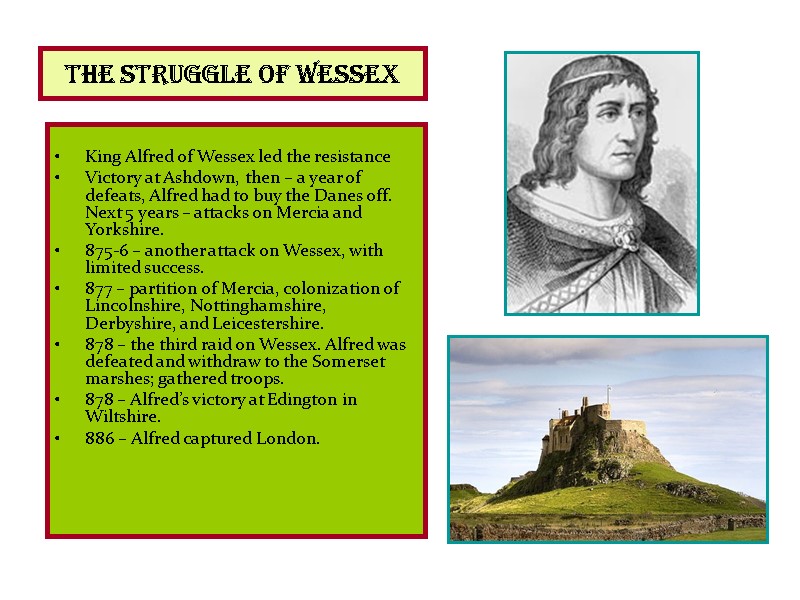
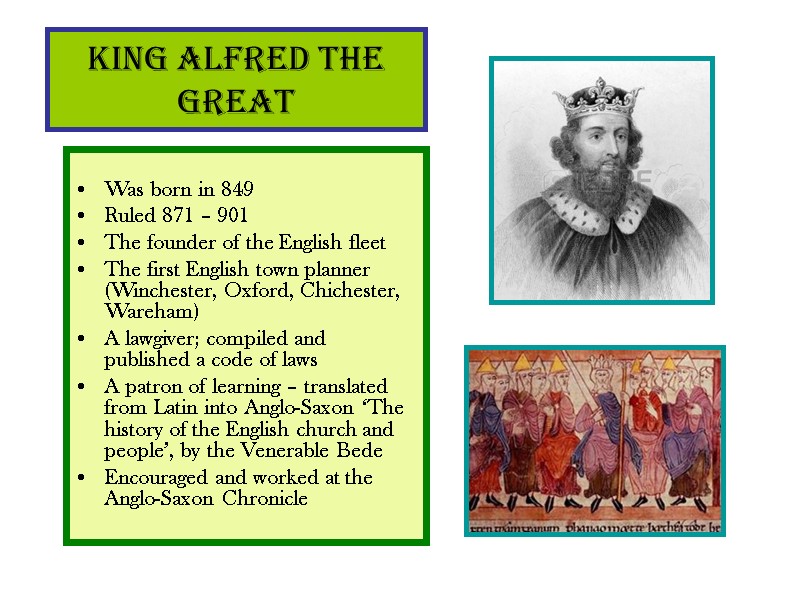
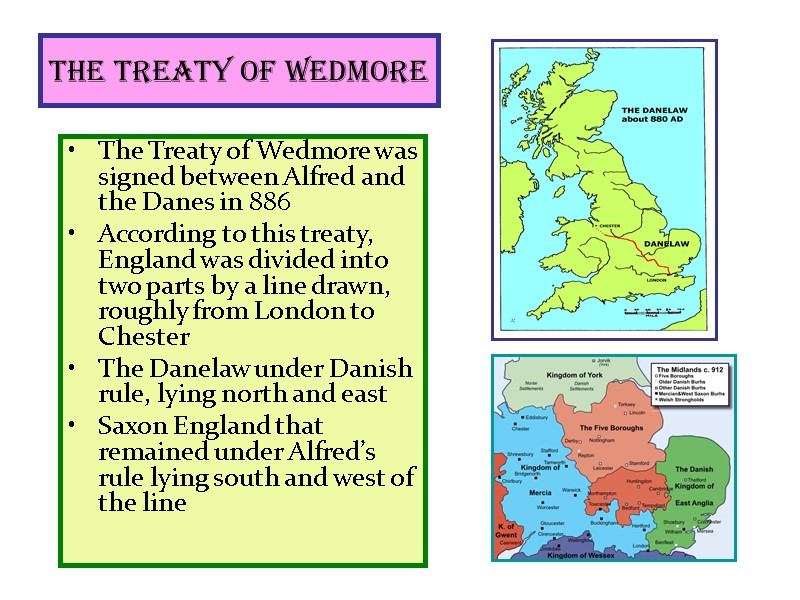
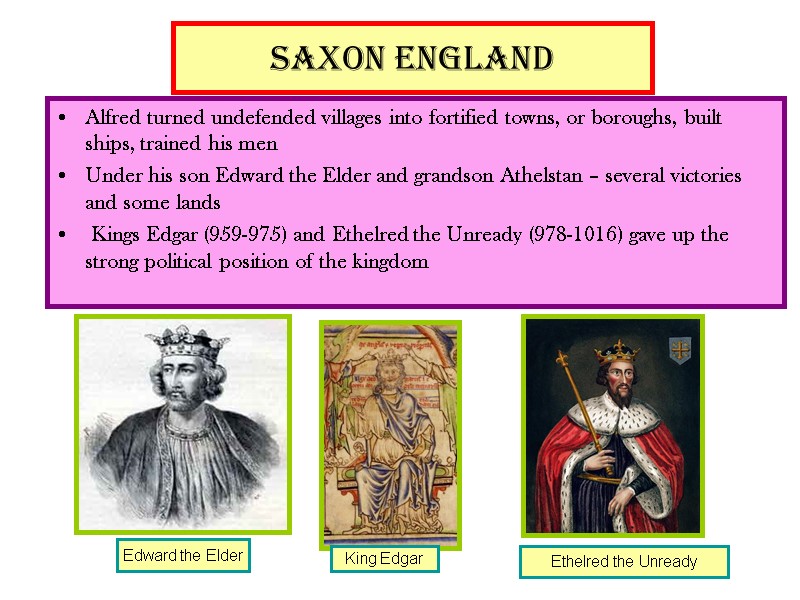
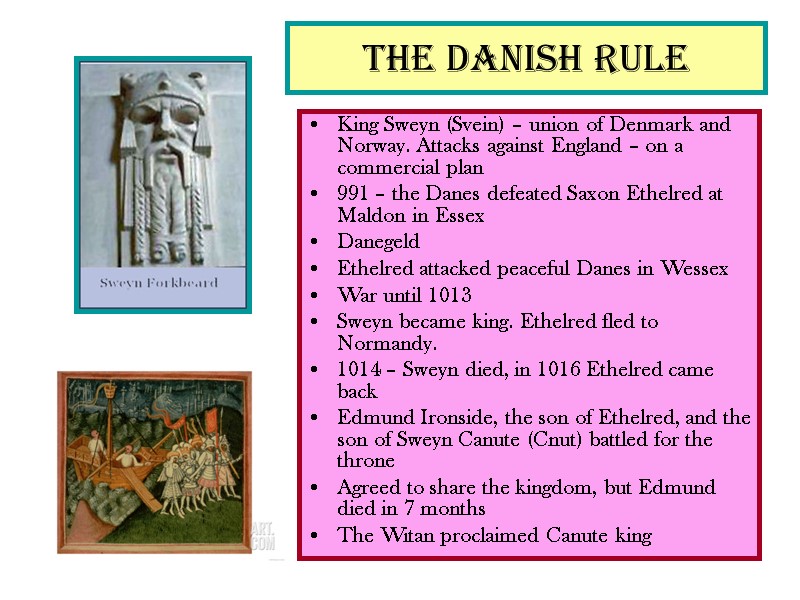
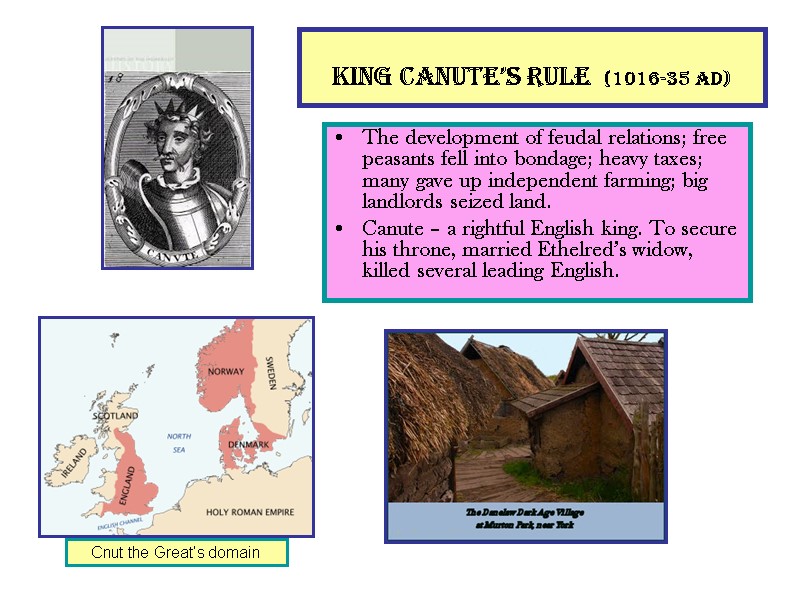
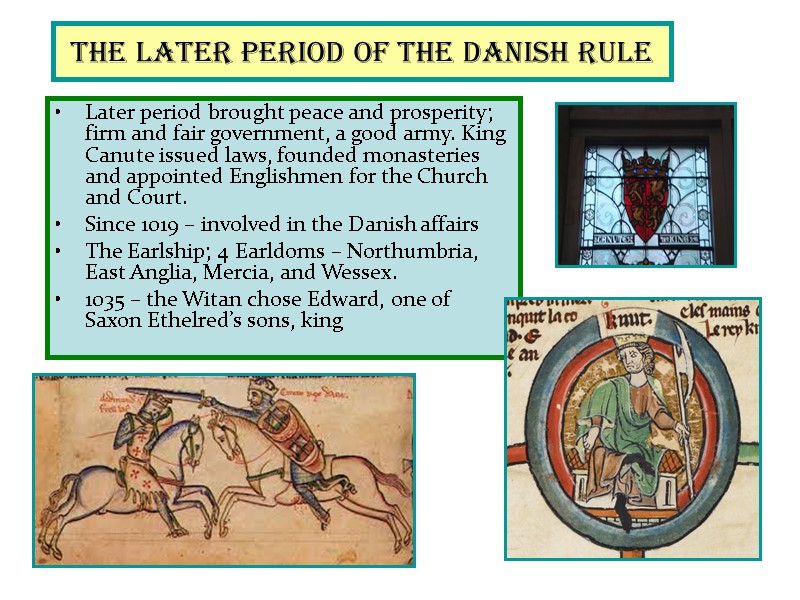
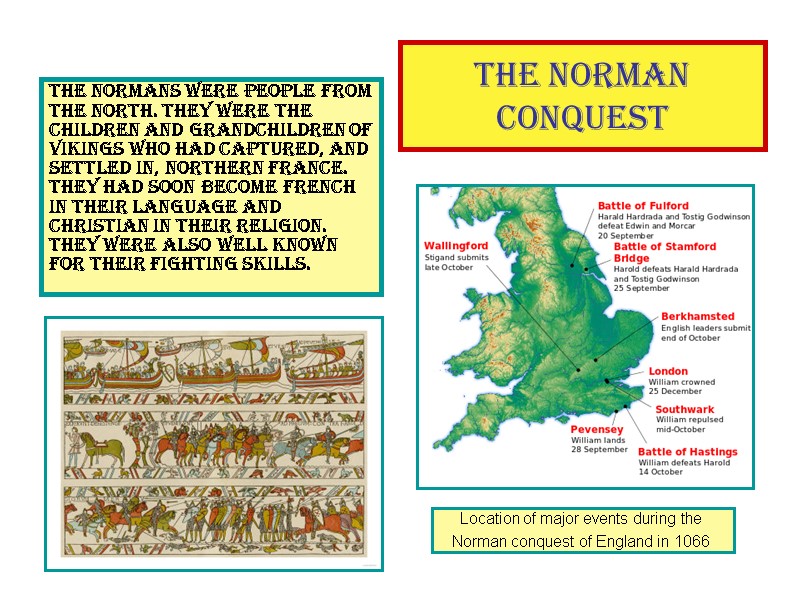
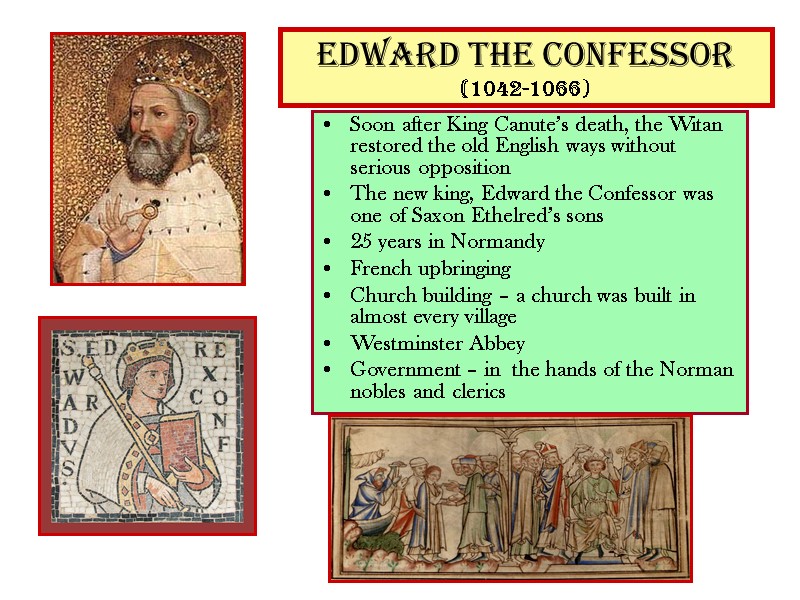

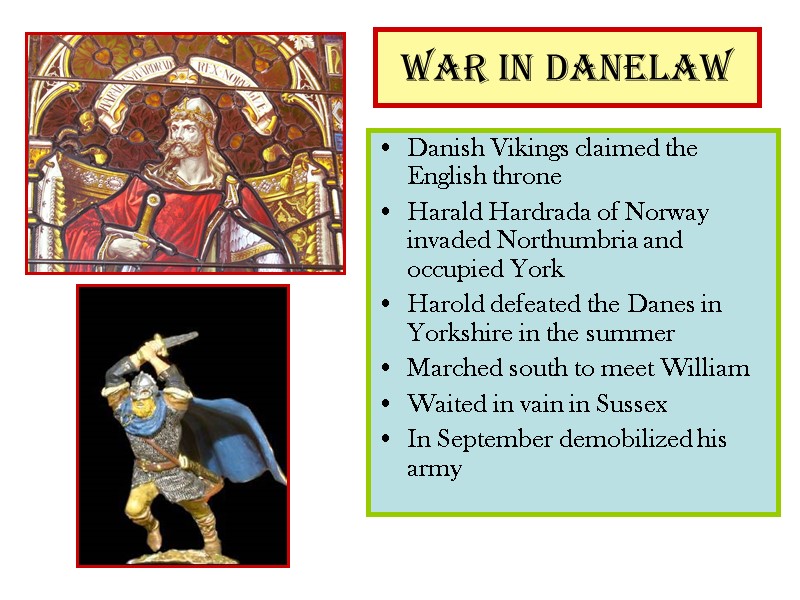
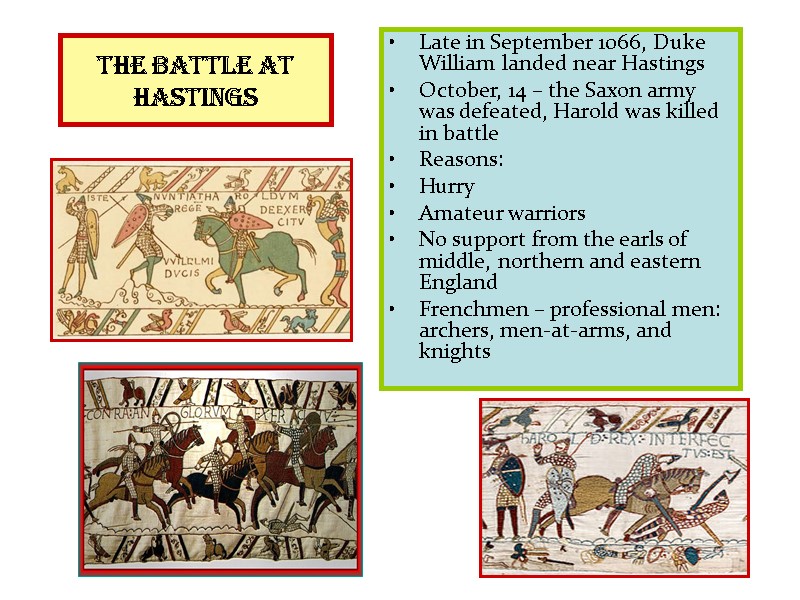
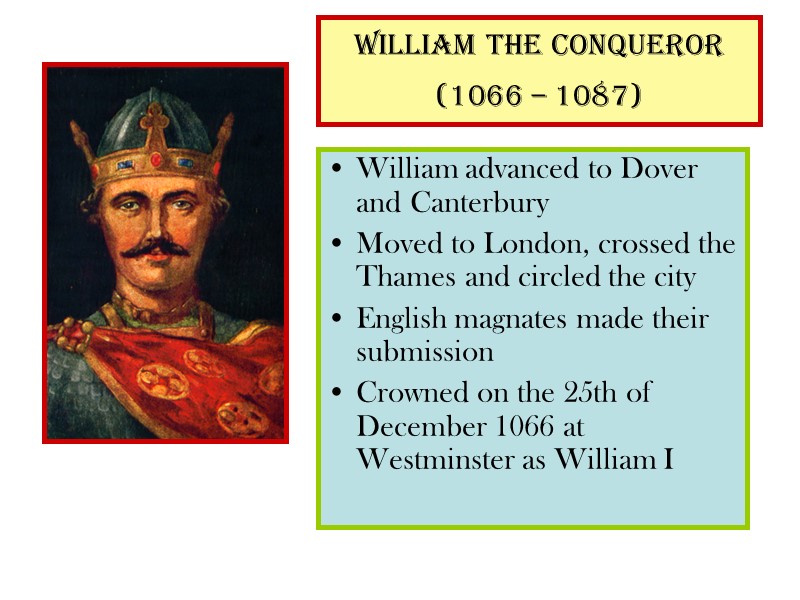
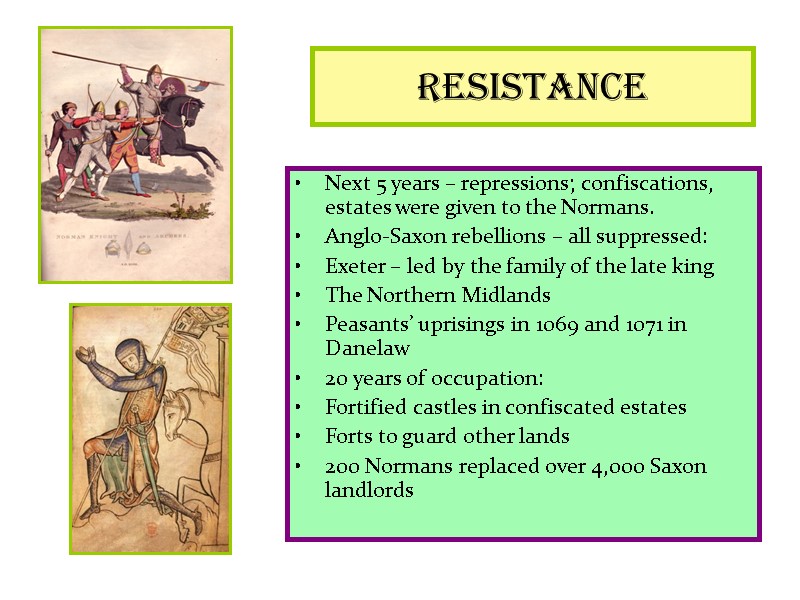
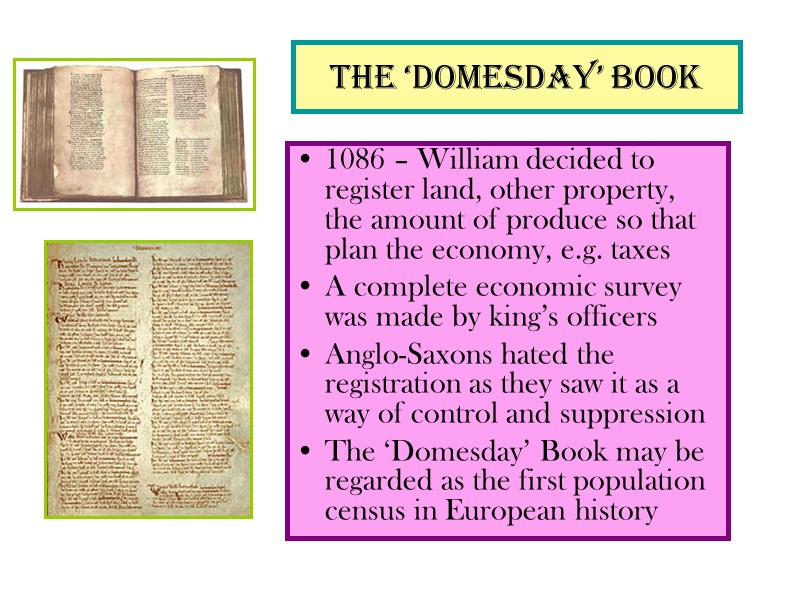
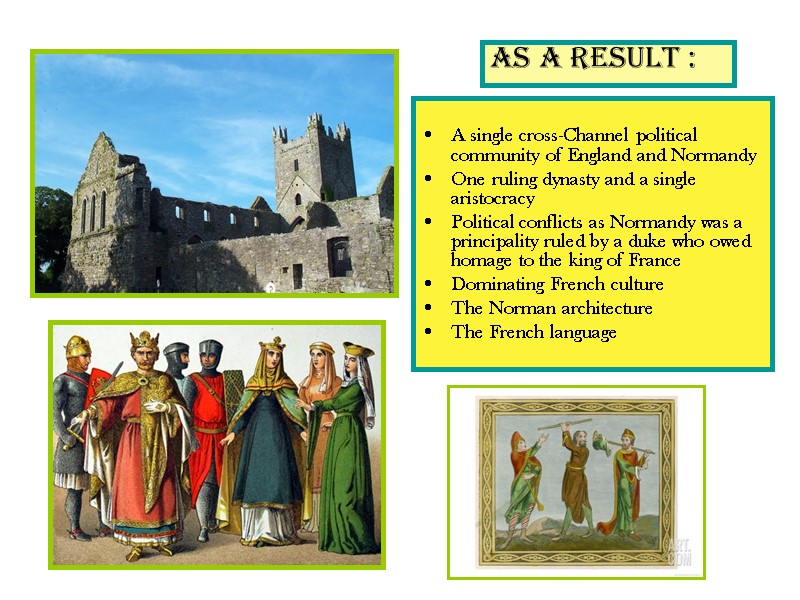
24942-powerpoint_anglo-saxons._danes.normans.ppt
- Количество слайдов: 25
 The Anglo-Saxon Conquest (5th – 8th cent. AD)
The Anglo-Saxon Conquest (5th – 8th cent. AD)
 The invasion 5th century – the British chiefs brought in a group of mercenaries and warriors from the Continent to defend the country The Angles, Jutes (from the Jutland peninsula / now southern Denmark) and Saxons (from Northern Germany) settled along the rivers A century of conquest; destruction, devastation and terror. The Celts’ withdrawal to the west, north and Ireland:
The invasion 5th century – the British chiefs brought in a group of mercenaries and warriors from the Continent to defend the country The Angles, Jutes (from the Jutland peninsula / now southern Denmark) and Saxons (from Northern Germany) settled along the rivers A century of conquest; destruction, devastation and terror. The Celts’ withdrawal to the west, north and Ireland:
 King Arthur According to Legend, the first Teutonic invaders of England were Hengist and Horsa, two Jutish princes that were invited by Vortigern, a king of the Britons, as mercenaries to help him fight off Pictish invaders. They liked the region so much however, that they founded a kingdom in Kent, and drove the Britons out of the area. Fifty years later, after several waves of new invaders had populated the region, the Britons did succeed in holding back the invaders at the battle of Mons Badonicus, and the migration of the invaders was apparently halted for a short time. This legendary battle is often associated with the King Arthur Legends. Kent continued to be an important Saxon Kingdom and was especially prosperous due to its close proximity to the Continent. It was also one of the first Saxon kingdoms to become Christian, around 600 A.D.
King Arthur According to Legend, the first Teutonic invaders of England were Hengist and Horsa, two Jutish princes that were invited by Vortigern, a king of the Britons, as mercenaries to help him fight off Pictish invaders. They liked the region so much however, that they founded a kingdom in Kent, and drove the Britons out of the area. Fifty years later, after several waves of new invaders had populated the region, the Britons did succeed in holding back the invaders at the battle of Mons Badonicus, and the migration of the invaders was apparently halted for a short time. This legendary battle is often associated with the King Arthur Legends. Kent continued to be an important Saxon Kingdom and was especially prosperous due to its close proximity to the Continent. It was also one of the first Saxon kingdoms to become Christian, around 600 A.D.
 The Picts and the scots The Picts’ origins are not definite. One theory is that they were an earlier form of Celts. Others contend they were a hybridization of the Beaker people and the earlier aboriginal peoples; others feel they came from Norway, which would account for their pale skin; another theory is that they were the early "Chaldees" or Galat" of Eastern Asia Minor. In the Old Stone Age, they penetrated westward into Gaul on the Atlantic. Recent DNA tests have proven the Picts were closely related to the Basques of Northern Spain. The Scots, on the other hand, were a branch of the Irish Celts or Gaels. Ireland was divided between the earlier Cruithne (Picts, who migrated from Scotland around 200AD) and later arriving Goidels (Gaels), who were constantly in the stae of war.
The Picts and the scots The Picts’ origins are not definite. One theory is that they were an earlier form of Celts. Others contend they were a hybridization of the Beaker people and the earlier aboriginal peoples; others feel they came from Norway, which would account for their pale skin; another theory is that they were the early "Chaldees" or Galat" of Eastern Asia Minor. In the Old Stone Age, they penetrated westward into Gaul on the Atlantic. Recent DNA tests have proven the Picts were closely related to the Basques of Northern Spain. The Scots, on the other hand, were a branch of the Irish Celts or Gaels. Ireland was divided between the earlier Cruithne (Picts, who migrated from Scotland around 200AD) and later arriving Goidels (Gaels), who were constantly in the stae of war.
 Anglo-Saxon kingdoms The Angles in the north and east (Northumbria, Mercia and East Anglia) The Saxons in the center and south (Wessex, Sussex and Essex) The Jutes in the south-east (Kent); Angle Land – England Family links: the village; 20-30 families loyal to the leader Churls (with a share of land); ‘hundreds’ and ‘shires’; a ‘shire reeve’; the common meeting - ‘moot’; a ‘manor’; ‘aldermen’ Agriculture as main occupation; a heavy plough, strips of fields, oxen on a cooperative basis; clearing and draining of land The King’s Council / the Witan
Anglo-Saxon kingdoms The Angles in the north and east (Northumbria, Mercia and East Anglia) The Saxons in the center and south (Wessex, Sussex and Essex) The Jutes in the south-east (Kent); Angle Land – England Family links: the village; 20-30 families loyal to the leader Churls (with a share of land); ‘hundreds’ and ‘shires’; a ‘shire reeve’; the common meeting - ‘moot’; a ‘manor’; ‘aldermen’ Agriculture as main occupation; a heavy plough, strips of fields, oxen on a cooperative basis; clearing and draining of land The King’s Council / the Witan
 Culture and religion Pagan beliefs; gods: Tiu, Woden, Thor , Frigga, Eostre Anglo-Saxon folklore - ‘The Poem of Beowulf’ (the 7th century) The official reintroduction of Christianity: 597 – Augustine came to Canterbury and became the first Archbishop of Canterbury in 601 The Celtic Church; preachers; monasteries, their role The Christian Church as a united body; the official adoption of Christianity at the Synod of Whitby in 664
Culture and religion Pagan beliefs; gods: Tiu, Woden, Thor , Frigga, Eostre Anglo-Saxon folklore - ‘The Poem of Beowulf’ (the 7th century) The official reintroduction of Christianity: 597 – Augustine came to Canterbury and became the first Archbishop of Canterbury in 601 The Celtic Church; preachers; monasteries, their role The Christian Church as a united body; the official adoption of Christianity at the Synod of Whitby in 664
 STRUGGLE AGAINST THE DANES (The Vikings) 8-11centuries
STRUGGLE AGAINST THE DANES (The Vikings) 8-11centuries
 The early settlements 8th century – new invaders: the Danes or the Vikings from Norway and Denmark 835 – a raid on Kent opened 3 decades of annual invasions Two main routes: 1/ round the north of Scotland to the Western Isles and to the south 2/ to the east and south coasts of England and to Gaul In Ireland, Wales and Cornwall – Norwegian settlements In the England and France – Danish The Vikings accepted Christianity and did not disturb the local population
The early settlements 8th century – new invaders: the Danes or the Vikings from Norway and Denmark 835 – a raid on Kent opened 3 decades of annual invasions Two main routes: 1/ round the north of Scotland to the Western Isles and to the south 2/ to the east and south coasts of England and to Gaul In Ireland, Wales and Cornwall – Norwegian settlements In the England and France – Danish The Vikings accepted Christianity and did not disturb the local population
 The Invasion 854 – the fall of the Danish royal dynasty left a power vacuum, with no strong king who could have united warriors and prevented them from raids. 865 the Danes invaded Britain. This time they came to conquer and settle. Anglo-Saxon kingdoms fought for dominance. The 6th – 7th century the most significant was Kent. The middle of the 7th century – Northumbria, the 8th century – Mercia, the beginning of the 9th century - Wessex. 829 – King Egbert of Wessex, union of all early feudal kingdoms, the center of such resistance.
The Invasion 854 – the fall of the Danish royal dynasty left a power vacuum, with no strong king who could have united warriors and prevented them from raids. 865 the Danes invaded Britain. This time they came to conquer and settle. Anglo-Saxon kingdoms fought for dominance. The 6th – 7th century the most significant was Kent. The middle of the 7th century – Northumbria, the 8th century – Mercia, the beginning of the 9th century - Wessex. 829 – King Egbert of Wessex, union of all early feudal kingdoms, the center of such resistance.
 The Struggle of Wessex King Alfred of Wessex led the resistance Victory at Ashdown, then – a year of defeats, Alfred had to buy the Danes off. Next 5 years – attacks on Mercia and Yorkshire. 875-6 – another attack on Wessex, with limited success. 877 – partition of Mercia, colonization of Lincolnshire, Nottinghamshire, Derbyshire, and Leicestershire. 878 – the third raid on Wessex. Alfred was defeated and withdraw to the Somerset marshes; gathered troops. 878 – Alfred’s victory at Edington in Wiltshire. 886 – Alfred captured London.
The Struggle of Wessex King Alfred of Wessex led the resistance Victory at Ashdown, then – a year of defeats, Alfred had to buy the Danes off. Next 5 years – attacks on Mercia and Yorkshire. 875-6 – another attack on Wessex, with limited success. 877 – partition of Mercia, colonization of Lincolnshire, Nottinghamshire, Derbyshire, and Leicestershire. 878 – the third raid on Wessex. Alfred was defeated and withdraw to the Somerset marshes; gathered troops. 878 – Alfred’s victory at Edington in Wiltshire. 886 – Alfred captured London.
 King Alfred the Great Was born in 849 Ruled 871 – 901 The founder of the English fleet The first English town planner (Winchester, Oxford, Chichester, Wareham) A lawgiver; compiled and published a code of laws A patron of learning – translated from Latin into Anglo-Saxon ‘The history of the English church and people’, by the Venerable Bede Encouraged and worked at the Anglo-Saxon Chronicle
King Alfred the Great Was born in 849 Ruled 871 – 901 The founder of the English fleet The first English town planner (Winchester, Oxford, Chichester, Wareham) A lawgiver; compiled and published a code of laws A patron of learning – translated from Latin into Anglo-Saxon ‘The history of the English church and people’, by the Venerable Bede Encouraged and worked at the Anglo-Saxon Chronicle
 The Treaty of Wedmore The Treaty of Wedmore was signed between Alfred and the Danes in 886 According to this treaty, England was divided into two parts by a line drawn, roughly from London to Chester The Danelaw under Danish rule, lying north and east Saxon England that remained under Alfred’s rule lying south and west of the line
The Treaty of Wedmore The Treaty of Wedmore was signed between Alfred and the Danes in 886 According to this treaty, England was divided into two parts by a line drawn, roughly from London to Chester The Danelaw under Danish rule, lying north and east Saxon England that remained under Alfred’s rule lying south and west of the line
 Saxon England Alfred turned undefended villages into fortified towns, or boroughs, built ships, trained his men Under his son Edward the Elder and grandson Athelstan – several victories and some lands Kings Edgar (959-975) and Ethelred the Unready (978-1016) gave up the strong political position of the kingdom Edward the Elder King Edgar Ethelred the Unready
Saxon England Alfred turned undefended villages into fortified towns, or boroughs, built ships, trained his men Under his son Edward the Elder and grandson Athelstan – several victories and some lands Kings Edgar (959-975) and Ethelred the Unready (978-1016) gave up the strong political position of the kingdom Edward the Elder King Edgar Ethelred the Unready
 The Danish Rule King Sweyn (Svein) – union of Denmark and Norway. Attacks against England – on a commercial plan 991 – the Danes defeated Saxon Ethelred at Maldon in Essex Danegeld Ethelred attacked peaceful Danes in Wessex War until 1013 Sweyn became king. Ethelred fled to Normandy. 1014 – Sweyn died, in 1016 Ethelred came back Edmund Ironside, the son of Ethelred, and the son of Sweyn Canute (Cnut) battled for the throne Agreed to share the kingdom, but Edmund died in 7 months The Witan proclaimed Canute king
The Danish Rule King Sweyn (Svein) – union of Denmark and Norway. Attacks against England – on a commercial plan 991 – the Danes defeated Saxon Ethelred at Maldon in Essex Danegeld Ethelred attacked peaceful Danes in Wessex War until 1013 Sweyn became king. Ethelred fled to Normandy. 1014 – Sweyn died, in 1016 Ethelred came back Edmund Ironside, the son of Ethelred, and the son of Sweyn Canute (Cnut) battled for the throne Agreed to share the kingdom, but Edmund died in 7 months The Witan proclaimed Canute king
 King Canute’s Rule (1016-35 AD) The development of feudal relations; free peasants fell into bondage; heavy taxes; many gave up independent farming; big landlords seized land. Canute – a rightful English king. To secure his throne, married Ethelred’s widow, killed several leading English. Cnut the Great’s domain
King Canute’s Rule (1016-35 AD) The development of feudal relations; free peasants fell into bondage; heavy taxes; many gave up independent farming; big landlords seized land. Canute – a rightful English king. To secure his throne, married Ethelred’s widow, killed several leading English. Cnut the Great’s domain
 The later period of the Danish Rule Later period brought peace and prosperity; firm and fair government, a good army. King Canute issued laws, founded monasteries and appointed Englishmen for the Church and Court. Since 1019 – involved in the Danish affairs The Earlship; 4 Earldoms – Northumbria, East Anglia, Mercia, and Wessex. 1035 – the Witan chose Edward, one of Saxon Ethelred’s sons, king
The later period of the Danish Rule Later period brought peace and prosperity; firm and fair government, a good army. King Canute issued laws, founded monasteries and appointed Englishmen for the Church and Court. Since 1019 – involved in the Danish affairs The Earlship; 4 Earldoms – Northumbria, East Anglia, Mercia, and Wessex. 1035 – the Witan chose Edward, one of Saxon Ethelred’s sons, king
 The Norman Conquest The Normans were people from the North. They were the children and grandchildren of Vikings who had captured, and settled in, northern France. They had soon become French in their language and Christian in their religion. They were also well known for their fighting skills. Location of major events during the Norman conquest of England in 1066
The Norman Conquest The Normans were people from the North. They were the children and grandchildren of Vikings who had captured, and settled in, northern France. They had soon become French in their language and Christian in their religion. They were also well known for their fighting skills. Location of major events during the Norman conquest of England in 1066
 Edward the Confessor (1042-1066) Soon after King Canute’s death, the Witan restored the old English ways without serious opposition The new king, Edward the Confessor was one of Saxon Ethelred’s sons 25 years in Normandy French upbringing Church building – a church was built in almost every village Westminster Abbey Government – in the hands of the Norman nobles and clerics
Edward the Confessor (1042-1066) Soon after King Canute’s death, the Witan restored the old English ways without serious opposition The new king, Edward the Confessor was one of Saxon Ethelred’s sons 25 years in Normandy French upbringing Church building – a church was built in almost every village Westminster Abbey Government – in the hands of the Norman nobles and clerics
 Harold Godwinson (1022-1066) Saxon opposition led Earl Godwin of Wessex; his daughter was married to the King 1052 Godwin died, succeeded by his son Harold Harold was taken prisoner in Normandy, which made him vassal of Duke William of Normandy Supposedly, promised to help William be chosen king 1066 – after Edward’s death, the Witan chose Harold as king William of Normandy started to prepare an invasion of England
Harold Godwinson (1022-1066) Saxon opposition led Earl Godwin of Wessex; his daughter was married to the King 1052 Godwin died, succeeded by his son Harold Harold was taken prisoner in Normandy, which made him vassal of Duke William of Normandy Supposedly, promised to help William be chosen king 1066 – after Edward’s death, the Witan chose Harold as king William of Normandy started to prepare an invasion of England
 War in Danelaw Danish Vikings claimed the English throne Harald Hardrada of Norway invaded Northumbria and occupied York Harold defeated the Danes in Yorkshire in the summer Marched south to meet William Waited in vain in Sussex In September demobilized his army
War in Danelaw Danish Vikings claimed the English throne Harald Hardrada of Norway invaded Northumbria and occupied York Harold defeated the Danes in Yorkshire in the summer Marched south to meet William Waited in vain in Sussex In September demobilized his army
 the Battle at Hastings Late in September 1066, Duke William landed near Hastings October, 14 – the Saxon army was defeated, Harold was killed in battle Reasons: Hurry Amateur warriors No support from the earls of middle, northern and eastern England Frenchmen – professional men: archers, men-at-arms, and knights
the Battle at Hastings Late in September 1066, Duke William landed near Hastings October, 14 – the Saxon army was defeated, Harold was killed in battle Reasons: Hurry Amateur warriors No support from the earls of middle, northern and eastern England Frenchmen – professional men: archers, men-at-arms, and knights
 William the Conqueror (1066 – 1087) William advanced to Dover and Canterbury Moved to London, crossed the Thames and circled the city English magnates made their submission Crowned on the 25th of December 1066 at Westminster as William I
William the Conqueror (1066 – 1087) William advanced to Dover and Canterbury Moved to London, crossed the Thames and circled the city English magnates made their submission Crowned on the 25th of December 1066 at Westminster as William I
 Resistance Next 5 years – repressions; confiscations, estates were given to the Normans. Anglo-Saxon rebellions – all suppressed: Exeter – led by the family of the late king The Northern Midlands Peasants’ uprisings in 1069 and 1071 in Danelaw 20 years of occupation: Fortified castles in confiscated estates Forts to guard other lands 200 Normans replaced over 4,000 Saxon landlords
Resistance Next 5 years – repressions; confiscations, estates were given to the Normans. Anglo-Saxon rebellions – all suppressed: Exeter – led by the family of the late king The Northern Midlands Peasants’ uprisings in 1069 and 1071 in Danelaw 20 years of occupation: Fortified castles in confiscated estates Forts to guard other lands 200 Normans replaced over 4,000 Saxon landlords
 The ‘Domesday’ Book 1086 – William decided to register land, other property, the amount of produce so that plan the economy, e.g. taxes A complete economic survey was made by king’s officers Anglo-Saxons hated the registration as they saw it as a way of control and suppression The ‘Domesday’ Book may be regarded as the first population census in European history
The ‘Domesday’ Book 1086 – William decided to register land, other property, the amount of produce so that plan the economy, e.g. taxes A complete economic survey was made by king’s officers Anglo-Saxons hated the registration as they saw it as a way of control and suppression The ‘Domesday’ Book may be regarded as the first population census in European history
 A single cross-Channel political community of England and Normandy One ruling dynasty and a single aristocracy Political conflicts as Normandy was a principality ruled by a duke who owed homage to the king of France Dominating French culture The Norman architecture The French language As a result :
A single cross-Channel political community of England and Normandy One ruling dynasty and a single aristocracy Political conflicts as Normandy was a principality ruled by a duke who owed homage to the king of France Dominating French culture The Norman architecture The French language As a result :

